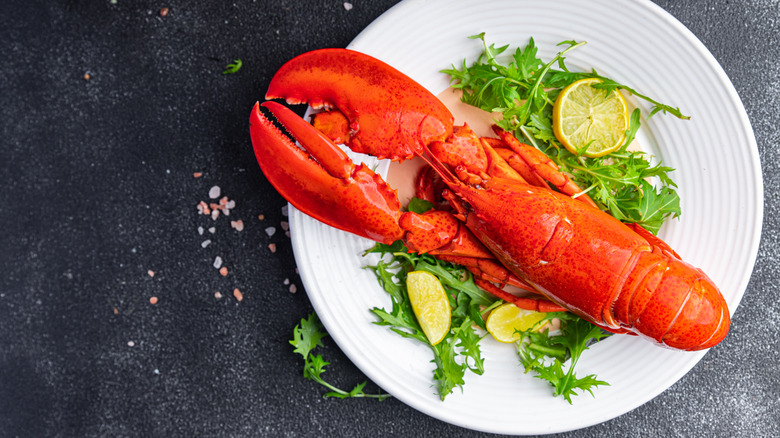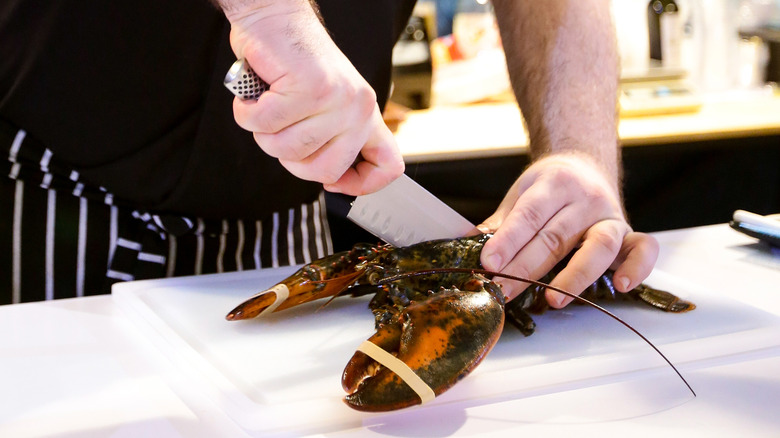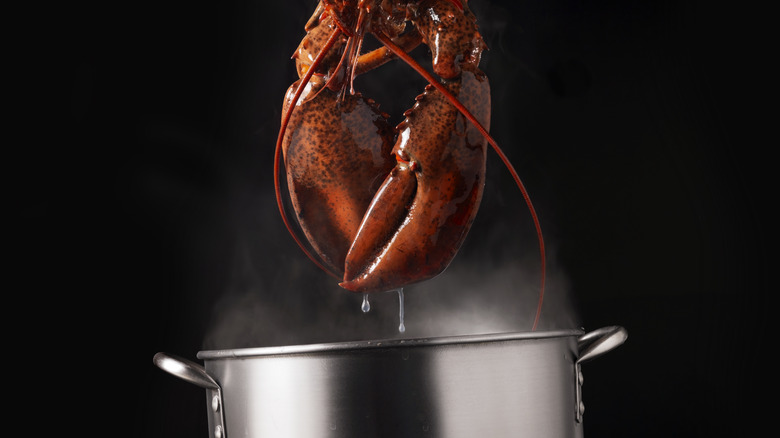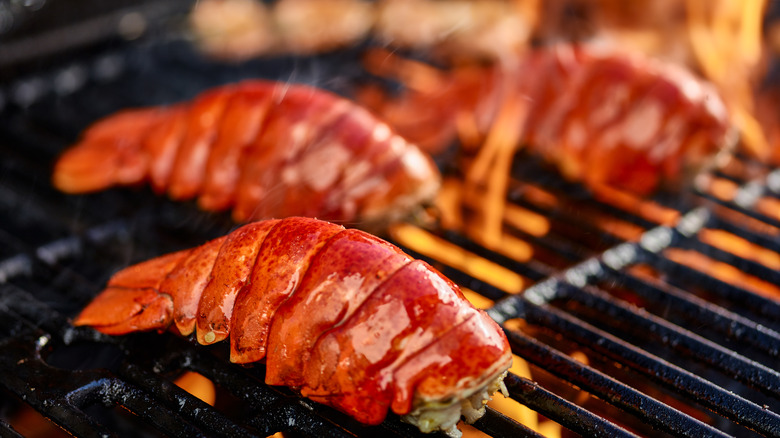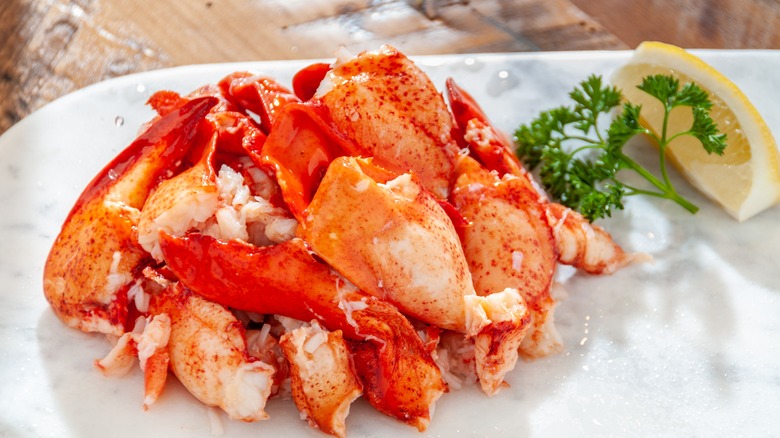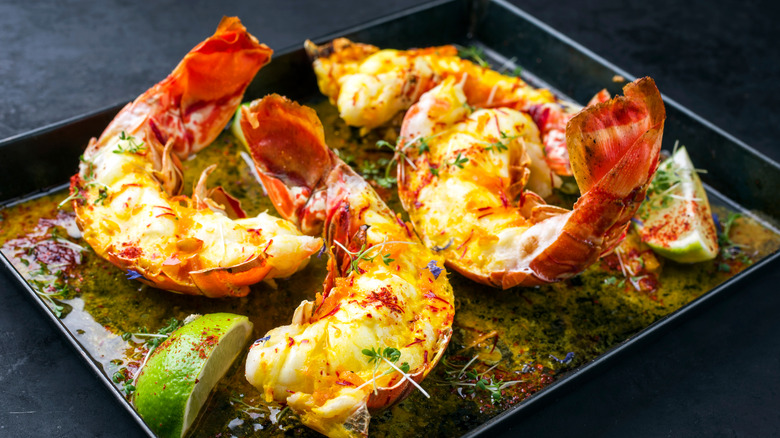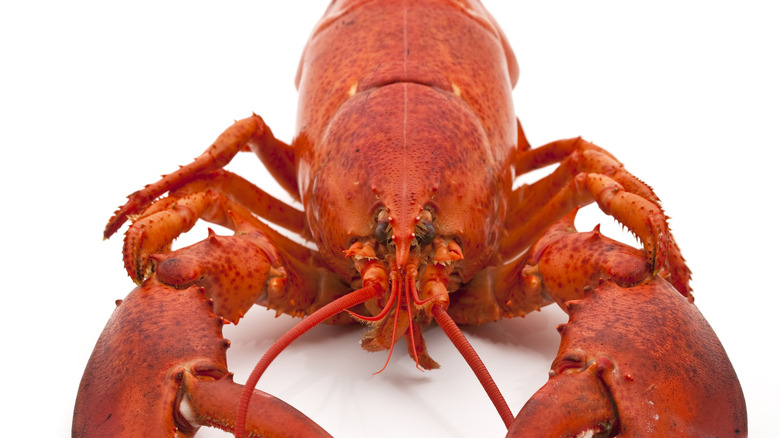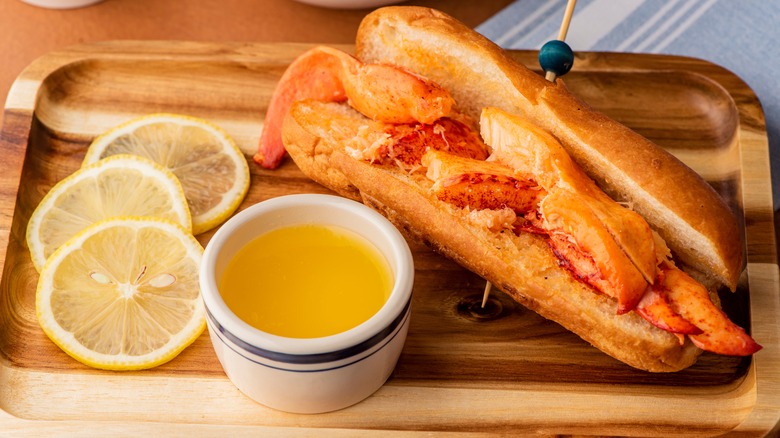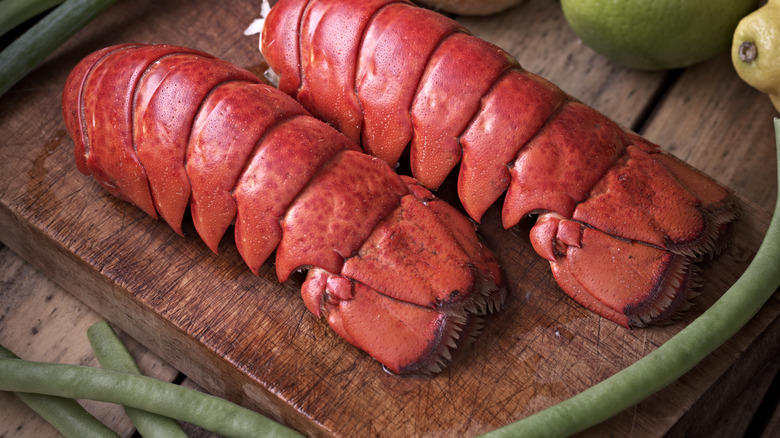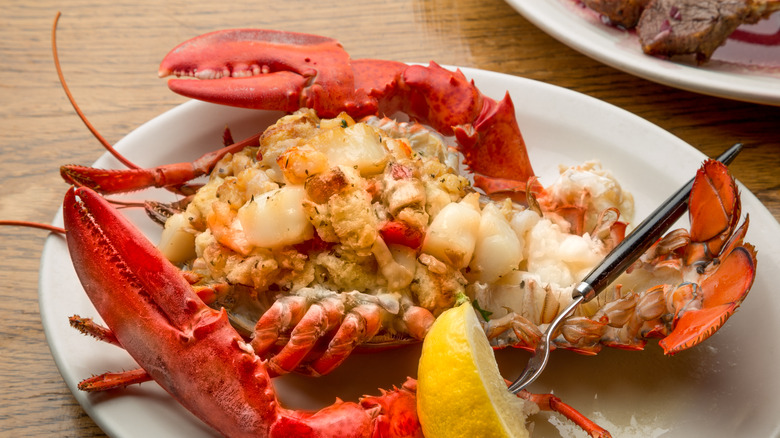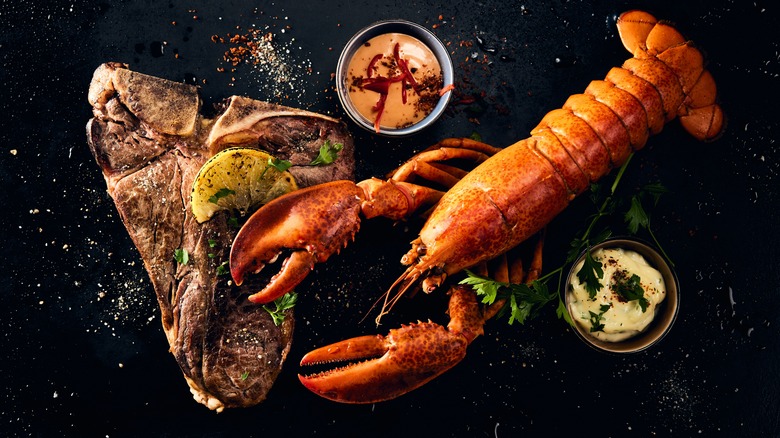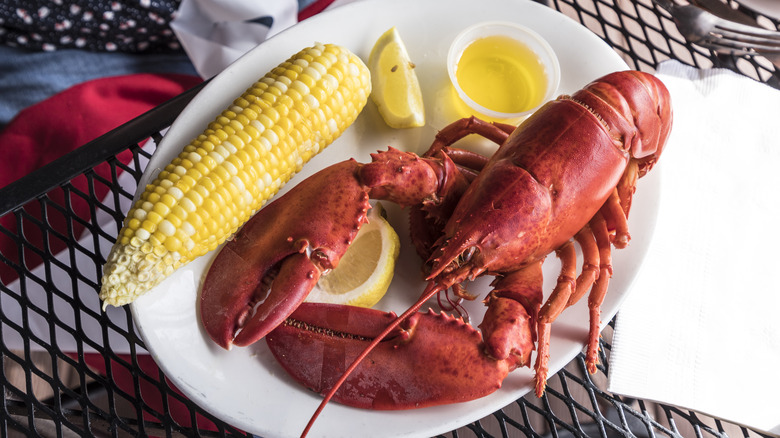11 Chef-Approved Tips To Upgrade Your Lobster Dinner
Any dish that calls for lobster is immediately cause for celebration. "It's just such a versatile and loved ingredient," explains Chef Matt Kreider of Steak 954 in Fort Lauderdale, Florida. "It can shine on its own, or it can be great with any number of sauces or presentations." And if you want to make it truly extraordinary, our chefs are here to help.
The very best lobster dinner begins at the fishmonger's market, where you'll want to take care to select only the freshest. "I buy them on the day I intend to cook them," says Chef Steven Richard of Paddlefish Restaurant at Disney Springs in Lake Buena Vista, Florida, "and always ask my fishmonger to show me each one before packing them up. If they don't look angry, I don't buy them."
Once you've made your purchase, it's time to choose your recipe — Richard warns against trying to add too many bells and whistles. "The foundation of all successful cooking is to start with the best ingredients, to understand them well, and to find ways to let them be what they are," Richard notes. "Very often, the best approach is the simplest one. Lobster is one of the best expressions of this way of thinking." With that in mind, he and other experts shared with Mashed their best tips on everything from killing a lobster humanely to cooking it to perfection and choosing the ideal accompaniments so you end up with a restaurant-quality lobster dinner every time.
Kill the lobster properly and humanely
If you want the freshest lobster, you're going to want to buy it live, chef Matt Kreider explains. "If they are dead," he says, "they can be old or start to deteriorate in quality." But buying live lobster means that once you get them home, you need to kill them — and while you may be tempted to just drop them into a pot of boiling water, this is far from the best way of dispatching with your crustacean.
Matt Conroy, who is executive chef at The Popal Group's Lutèce and the newly opened Pascual, currently uses lobster at both restaurants in Washington, D.C. "We cut quickly through the head to kill before cooking," he says. "In theory less stress is caused." You'll want to do this knifework quickly and, preferably, in one fell swoop. "You don't want to harm the meat or destroy the structure of the claw/tail in any way during the killing process," explains Chef Jeff McInnis of Stiltsville Fish Bar in Miami Beach, Florida. "Any major blow towards the internal cavity could rupture stomach acids and be harmful to the texture of the meat."
Perhaps even more important than how you kill the lobster, however, is when. "Timing is more important than method," chef Steven Richard says. "Cooking a lobster that is already dead can affect the texture of the meat. The longer the delay, the greater the liability."
Season the cooking water well
Once the lobsters are dispatched, one of the most common ways of cooking them is in a large pot of boiling water. But before you add the lobster, it's essential to season the poaching liquid, according to chef Matt Kreider of Steak 954. "If you were to put it into a pot of unsalted water, it would pull the salinity from the lobster and reduce the natural flavors," he says.
Chef Steven Richard agrees, noting that "one of the biggest differences between home cooking and restaurant cooking is simple seasoning." He seasons the liquid for his lobster not just with salt but also with lots of lemon for even more fresh flavor.
As for how much salt to use, chef Oliver Melgar of Raised, an Urban Rooftop Bar in Chicago, has a simple solution: "You want the water to be as salty as the sea." He prefers using sea salt, which will help to bring out the natural briny flavor of the lobster. If saltwater isn't available, the New England-based mail order seafood company LobsterAnywhere recommends using 2 tablespoons of salt per quart of water to boil your lobster.
Consider alternate cooking methods like steam or the grill
While poaching may be the most common way of cooking lobsters, it's far from the only method. Chef Matt Conroy prefers steaming, noting this method prevents thermal shock, making it less likely you'll overcook them. And many of the chefs we consulted love to add a bit of a char to lobster by taking advantage of the grill. "Anything cooked over a live fire will enhance the flavor," says Anthony Dirienzo, head chef of Bazaar Meat and Bar Mar in Chicago.
Alex Oradei, executive chef at Balos in Washington, D.C., agrees. "Lobster on the grill is always a great way to switch it up," he says. "Doing so adds some smoky notes to the dish." Florida-based chef Jeff McInnis prefers to poach his lobster first to "set the meat" and then finish it on a grill with low heat and loads of flavored butter.
But not all of our chefs love grilled lobster. Chef Oliver Melgar prefers his lobster poached in butter, which he says brings out its fullest flavor. "While cooking on the grill, you are more prone to the loss of flavor," he says. "Either the seasoning sticks to the grill, or the high heat burns the seasoning. It's getting the right balance between cooking the lobster long enough to release the flavor, but also short enough to avoid flavor loss. Grilling lobster gives the meat a smoky flavor, while poaching gives it a more tender and succulent taste."
Slightly undercook lobster for the perfect texture
No matter which cooking method you choose, one thing is sure: Perhaps the worst crime to commit against lobster is overcooking it. Unfortunately, according to chef Matt Conroy, it's fairly easy to do — and once you've overcooked it, there's no coming back from the dry, chewy, unappetizing texture. Chef Anthony Dirienzo cautions: "Better to err slightly under than risk an overcooked tail ... however, claw and knuckles need to be cooked through."
It's for this reason that he and other chefs often opt to undercook the lobster slightly, especially if it's going to be reheated later. That way, chef Matt Kreider says, "I can just finish it when I'm ready." He adds that he wouldn't serve undercooked lobster. "The texture is not right," he says, noting that one exception would be if you were making a lobster ceviche, where the juices would help "cook" the lobster to perfection. Jeff McInnis also par-cooks his lobster before grilling it.
Steven Richard partially cooks the meat when doing a pasta sauce, which would see the crustacean reheated before serving. If you're going to use this chef-tested trick at home, Richard recommends first poaching the lobster, slightly undercooking it, and chilling it quickly to stop the cooking. "Harvest and reserve the meat, and then add it to your dish near the end of cooking," he says. "If you're going straight to the plate, you just need to make sure not to overcook your lobster."
Include a touch of spice with your lobster
Lobster is delicious all on its own, but some chefs like to take advantage of spice to bring out even more of the flavors of the shellfish. Such is the case for chef Hélène Darroze, who is famous for her tandoori-spiced lobster at her two-Michelin-starred restaurant Marsan, which is located in Paris. Chef Matt Conroy pairs lobster with epazote and a roasted habanero salsa for some Mexican vibes on the menu at his Pascual restaurant, while serving it with a vadouvan curry blend for a touch of heat at Lutèce.
"Lobster and spice go well together," asserts chef Matt Kreider, who notes you can lean more toward chile heat or to "clean, nuanced juniper." He also favors poaching lobster in grapefruit and chamomile. At Paddlefish, chef Steven Richard says he serves lobster in the seafood boil kettle, which is seasoned "aggressively" with salt, lemon, and a custom spice blend. "It's also important to note that the seafood boil kettle runs all day and becomes more flavorful over time," he says.
For Jeff McInnis of Stiltsville Fish Bar, spice can "overpower the light flavor of a good lobster." It's for this reason he relies instead on milder fresh herbs, like basil, tarragon, cilantro, chervil, or chives, which he says are "better than any dry/heavy concentrated seeds in my opinion."
Don't fear simplicity when cooking lobster
While there are loads of ways you can doll up your lobster, for many chefs, simplicity is the best way to make the flavors of the crustacean sing. "The trajectory of my cooking is that it has become simpler over time," chef Steven Richard says. "I don't find fault in taking an ingredient like lobster and trying to elevate it, but it should be done thoughtfully."
For chef Matt Conroy, the ideal lobster sticks close to the traditions of his childhood. "I grew up in New England," he says, "so it's a toasted bun with just a touch of mayo or simple drawn butter for me."
Chef Jeff McInnis agrees, noting that he believes lobster should always be seasoned with a very light touch. "You don't want to overpower the light flavor of a good lobster," he says. "Simple lemon/garlic butter with sea salt is a win! [It can be] finished with a little fresh herbs."
Add flavor to your drawn butter
One of the most common accompaniments for lobster and lobster rolls is drawn butter, a dipping sauce made either by clarifying butter or by simply melting butter before serving it alongside the lobster. But while butter on its own is pretty perfect, you can also season it slightly for even more flavor. "A squeeze of grilled lemon goes a long way," according to chef Anthony Dirienzo. Chef Matt Kreider recommends adding herbs. Particularly when he's grilling lobster, he says, "I like to finish it with a nice compound butter, like a lemon tarragon butter."
Chef Oliver Melgar, too, adds fresh herbs to his butter, with a preference for those with a slight citrus undertone, such as sage, rosemary, dill, thyme, parsley, or tarragon. "It is a small process," he says, "but makes a huge difference with the flavor at the end."
Kreider sometimes likes to add slightly more assertive flavors to his butter. "I think we can all agree garlic is never a bad choice," he says. "I think a nice chile like an arbol works as well." Chef Alex Oradei even adds blackened seasoning from time to time, saying it "does wonders when needed." But for chef Steven Richard, the same tenets that govern the seasoning of lobster should be used when seasoning this sauce. "Sea salt is about the only thing I would recommend adding to drawn butter to be served with lobster," he says.
Get all the flavor out of the shells
Extracting the lobster from its shell may be a bit of a finicky task, but the payoff will be twofold: Not only will you get to dig into the succulent meat, but the shells themselves will also be ready to transform and repurpose. "Stock! Soup! Base!" suggests chef Matt Kreider, who notes that the legs in particular have "a lot of great flavor."
Each time you make lobster, do as chef Steven Richard does and freeze the shells and bodies. "When I have enough," he says, "I roast them in the oven to develop color and flavor and simmer them with mirepoix." The stock will keep for months in the freezer, ready to use as the base for a variety of recipes. At Balos, chef Alex Oradei says, the shells are used as stock that goes into the restaurant's popular lobster pasta dish. At Pascual, chef Matt Conroy notes, shells are used to make a sauce for lobster tetela, a stuffed masa treat hailing from Oaxaca.
Chef Oliver Melgar, meanwhile, likes transforming shells into a flavorful lobster bisque. First, he roasts the shells; then he adds them to a pot with a mirepoix and deglazes it with brandy. He then adds vegetable stock and simmers for six hours before adding cream and blending with a Vitamix. "Strain through a chinois to ensure no lobster shells go into the bisque," he cautions. "The final product is a delicious, creamy and rich lobster bisque."
Give your lobster a great stuffing
Adding stuffing to lobster is a great way to create texture and flavor, and there are as many stuffing recipes as there are cooks. Chef Steven Richard recalls a dish his grandfather would make when he was growing up in New England. "When I was a kid, he would do a cornbread stuffing for lobster and sometimes shrimp," he says. The sweetness of the cornbread plays wonderfully with the seafood.
Anthony Dirienzo, head chef of the Bazaar Meat and Bar Mar restaurants, also takes advantage of New England tradition with what he calls "my favorite summertime dish," which is a grilled, baked, and stuffed lobster. "It has crab, shrimp, and scallops ... it's like the Thanksgiving of the ocean," he says.
Lobster thermidor is a decadent but classic dish that has the lobster drizzled with a rich, creamy, herb-infused sauce and topped with Parmesan cheese. You could even do as the Red Lobster restaurant does and use the chain's famous Cheddar Bay biscuits as a stuffing base!
Choose good costars for your lobster
Lobster can easily stand all on its own, but it also works well as part of a bigger dish. Surf and turf is a classic, where lobster is paired with steak such as tender filet mignon for a double-barreled approach to luxury dining. A side of mashed potatoes, chef Alex Oradei says, is the perfect accompaniment.
But that's not the only way lobster can share the spotlight. Chef Jeff McInnis likes adding lobster to his grapefruit salad, while Matt Conroy loves stirring lobster meat into an omelet with ramps (a type of wild onion), maitake mushrooms, and a classic French sauce Américaine. The protein can even be transformed into a truly decadent lobster mac and cheese. Some of our chefs also love featuring lobster in seafood stews like Italian cioppino or Marseillaise bouillabaisse.
For Steven Richard, some of the best costars for lobster are other sought-after seafood, such as Ipswich steamer clams. "These clams have a softer shell and are sweeter and more delicate than littlenecks or middlenecks," he says. "They are difficult to find outside New England but are worth the hunt."
Select exciting sides for your lobster
If lobster is indeed going to be the headliner for your meal, it still need not stand alone. "A simple side can go a long way," says Oliver Melgar, the chef at Raised, an Urban Rooftop Bar in Chicago. "It can complement and enhance the flavor of the crustacean without breaking the bank." He says he loves serving lobster with roasted asparagus seasoned with garlic and mashed potatoes.
Chef Anthony Dirienzo also goes the way of the spud, opting for a warm potato salad. Chef Matt Kreider, meanwhile, loves pairing lobster with chanterelles, noting that the pairing is delicious, albeit surprising. "I don't think most people think of mushrooms when they think about lobster," he says.
One classic pairing for lobster is corn. Dirienzo likes grilled corn on the cob, while Jeff McInnis loves grits, polenta, or cream corn. "Something about the sweetness of the corn compliments the lobster so well," he says. But no matter which side you choose, according to Alex Oradei, "Lobster is always the star!"
